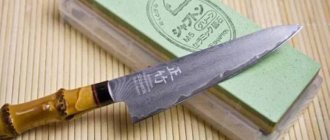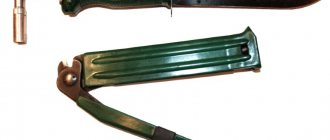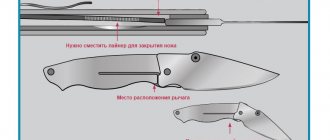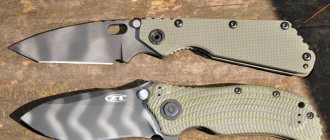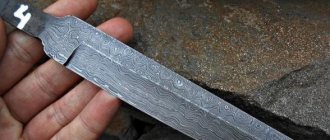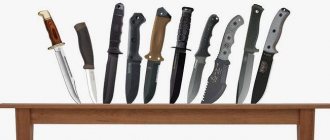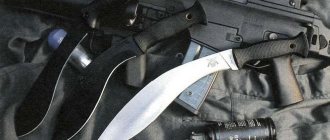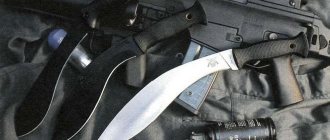As a competition, knife throwing came to us from time immemorial, when warriors, wanting to demonstrate their dexterity and skill, organized a kind of review of the skills of a male defender.
Centuries have passed, views and attitudes have changed, but knives have remained as part of the weapons in some branches of the military, and the ability to operate them continues to attract the attention of people of different ages.
As a sport, it was born quite recently. At the end of the 20th century, the Russian, and at the beginning of the 21st, the International Amateur Federation “Universal Fight” was created, under the auspices of which competitions in sports knife throwing are held.
Types of throwing knives and their examples
There are many types of throwing knives. The typical handle of such a knife is its tang. The design is uniform. With rare exceptions, the handle is made from other materials. The main difference between throwing cutters is their blade shape. Each of the directions should be considered in more detail.
Sports
For fun, it is permissible to throw any knife into a wooden surface. But keep in mind that not everyone can withstand shock loads. A sports throwing knife is a special projectile to which special requirements apply.
There is no guard or stops, the knife is completely metal. Holes are sometimes drilled into the shank for better ballistics. Requirements for competitions apply:
- blade size – 150 mm;
- total length of the product – 260 mm;
- weight – 285 grams.
A certificate confirming that the products belong to sports equipment is required. They are also marked with the inscription - Unifight. Unifight throwing knife is the world standard for a complex sport. For sports knife throwing in competitions, three types of blades are used:
- Sturgeon. It has the widest distribution among its fellows. The blade is slightly curved, non-sharp, single-sided sharpening. The sturgeon throwing knife got its name because it resembles the shape of the fish of the same name.
- Leader. The leader throwing knife is shaped like a spear tip. Well balanced product towards the blade. The blade is not wide, suitable for beginner knife throwers.
- Unifight PRO. The unifight pro throwing knife is a professional product. They are performed in two variations: male and female. Curved, slightly sharpened cutting edge, with a wide blade. Narrow and straight handle without pads. The women's model is lightweight.
There are many sports blades for throwing, they differ in the shape of the blade. The handle of almost all products is the same. There are forms: dagger, leaf-shaped, arrow knives, scalpel knives and pike knives. You can see the external features of some products in the pictures:
Japanese knives. Throwing knives. Throwing knives with wrapped handles. Throwing knives of different colors. Sports knives of different shapes. Throwing knives.
Japanese throwing knives
The Land of the Rising Sun has always been famous for military edged weapons. Famous samurai swords and ninja throwing stars. They are constant attributes of movie characters in films. Japanese throwing knives exist in real life, several models of them:
- Shaken. The product is a small blade in the form of a star plate, not necessarily five-pointed. There are four, six and eight protrusion faces. There is a hole in the middle. The diameter of a shaken knife ranges from 100 to 180 mm, the thickness of the product is from 1 to 3 mm. Throwing a knife is carried out at a distance of 12 to 15 meters.
- Shuriken. An interesting type of throwing weapon. These are metal rods with a varying number of pointed edges at the tip. The weight of a shuriken knife ranges from 30 to 150 grams. The sizes also change proportionally from 12 to 25 cm. They are thrown at a distance of 7-8 meters.
- Kunai. Japanese throwing dagger. Initially, the item was an agricultural tool. The ninja noticed the product and included it in their arsenal. Kunai throwing knives are made in various variations. On average, they have a length of 200 mm, a butt thickness of 4 mm, and a weight of about 80 grams. Just like a kunai knife reaches the target at a distance of 8-10 meters.
The numbering in the picture corresponds to the list presented above.
Military items are intended for concealed wear. With small sizes this is easy to do. And the kunai knife is removed from the sheath by the ring on the top of the handle.
Combat knives
In reality, survival knives or products in service with the army are of little use for throwing.
They are used more for camping and household needs or in case of hand-to-hand combat. The handles of such knives are made powerful and comfortable to grip.
When thrown, few knives will achieve an accurate hit on the target. Much depends on how the cutter is balanced. Nothing depends on the strength of the throw; you rarely meet a person who knows how to throw a combat knife. The technique of this art will be described below.
Throwing daggers
Many manufacturing companies produce daggers suitable for throwing. Among them are domestic companies, which is very encouraging. Let's look at the most popular daggers:
- Beam B. An excellent option for a beginning athlete. The total length is 305 mm, 186 mm is allocated to the blade. The cutter weighs little - 65 grams.
- Swift. Suitable for a woman's hand, the product is small in size and quite light. The total length of the product is 217 mm.
- TRUE FLIGHT THROWER. How would we be without the famous American company Cold Steel. An exquisite dagger for professionals. A weighty product weighing 275 with a total length of 305 mm.
- Vyatich. A perfectly balanced product. Suitable for non-revolving throwing and throwing with a blade grip. The total length of the knife is 224 mm.
- Chance. The dagger is specially designed for throwing and is produced by SARO. With a total length of 280 mm and a butt thickness of 3.5 mm, it weighs a little - 65 grams. The blade has 160 mm.
There is a choice. But you should pay attention to the direction of the dagger. It will be difficult for a beginner to handle a cutter designed for a professional. More interesting options:
- Impulse . With a large weight, but with a shifted center of gravity, the cutter perfectly hits the target with the blade. It is suitable for beginners;
- Petal . The knife has a smooth transition from the cutting edge to the handle. A long and heavy projectile for throwing, more suitable for professionals;
- Vyatich . It is mentioned above, but it should be added that the dagger is quite versatile. Both professionals and beginners can handle it. It is suitable for learning various throwing techniques.
Simple but durable forged knives for throwing.
Some daggers and throwing knives are made using forging. When entering the target, the metal endures considerable loads. The strength of a forged cutter is higher than the serial version; it depends a lot on the grade of steel and the method of hardening the blade.
Throwing knives with unusual shapes
Design solutions are sometimes surprising. But you shouldn’t get carried away - it won’t do any harm. There are knives with unusual shapes, but they are quite suitable for throwing:
- a good solution for changing the center of gravity is a moving washer along the blade;
- the knife is a jack, it has no handle, there are two blades, and it is permissible to throw it with either end;
- shurikens in the form of thickened nails;
- shakens are flat star knives;
- the blade and handle have slots to reduce weight; this solution is available on Smith & Wesson SWTK10CP knives;
- Sometimes you can find throwing knives with a guard - an excellent example is the American Cold Steel 80PGTK GI Tanto cutter;
- guitar-shaped blade on the United Cutlery GH2033 Gil Hibben knife.
Excellently balanced throwing knives - Smith & Wesson.
All knives are suitable for throwing. Some will have to get used to. Skeleton handles help in balancing the knife to the blade and make the cutter lighter. Throwing products are often used in everyday life. By winding the cord around the handle, you will get a good home helper.
Throwing Knife Randy
But the most unusual product is Randy's knife. We were stunned to learn that such a product was so popular. In reality it does not exist. We don’t have a gaming site, but if people are interested, we’ll tell you briefly. Randy's Throwing Knife is a high-velocity rifle in Destiny 2: Shadowkeep. Now the reader is in the know.
Regular forms
More common products that are used as sports equipment have simple shapes. There is no need to surprise the judges with the beauty and unusualness of the knife. Yes, and there are certain standards for sports products. These profiles include:
- heavy professional cutters with a dagger blade with one-sided sharpening;
- spear-shaped blades, where the handle is slightly larger;
- the smooth transition of the wedge into the handle is classified as a peak;
- a wide, leaf-shaped blade that is thrown while holding the hilt.
A great piece of 80PGTK GI Tanto with a guard from Cold Steel.
The sturgeon knife has a slightly curved main part. But it is classified as a standard throwing knife. It has won its recognition for its convenience and versatility.
With mercury core
A controversial development by Soviet and American designers. Some consider these knives to be a myth. Today you will not find a single copy, even from collectors. But there is an opinion about attempts to construct a cutter by the Russian Federation in the 90s of the last century.
The operating principle of the product consisted of a capsule containing liquid metal. It was built into a longitudinal cavity inside the blade. And when thrown, the capsule had to move towards the tip. This changed the balancing of the cutter. And he moved towards the target with his blade.
Manufacturing technology
photo throwing knives now ; they are presented in huge quantities on the Internet. Despite the fact that in principle any knife can be thrown, there are still special designs designed for this. For example, to improve the movement of a body thrown in space (ballistics), the blade itself is made heavier compared to the handle. The throwing knife is often spear-shaped and may have no blade at all.
The process of making a really good throwing knife takes a long time and requires a lot of patience. Steel for throwing knives should be hard, but not very brittle. In some cases, a spring type of steel is used, which is found in cars and trucks. In cases where it is too thick or crooked, it is necessary to forge it in a forge, and the forging must be hot. As a result, the steel plate must be at least 4 mm thick.
At the next stage of production, it is necessary to decide on the shape. Ideally, it will be without recesses, protrusions and holes, in a word, as simple as possible. It is important that the knife fits well in your hand and is not too small. The most difficult step is grinding the thickness of the plate to the desired size. If you do this yourself, you need to be prepared for the fact that it will take a lot of time.
Next comes the sharpening procedure. Sharpening of throwing knives is carried out using whetstones and whetstones. To begin with, take a rough block and sharpen it so that a burr (a thin strip of metal) appears along its entire length. From this you can understand whether you will be able to sharpen the blade in the future. When sharpening, it is important to ensure that the resulting blade is even. Sometimes, in the area of the nose, the knife is sharpened from the top and bottom sides.
Balancing characteristics
There are 3 types of balancing: neutral, in the blade or handle area. Products of the first group can be thrown at a target from any distance in two ways: by holding the blade or by the handle.
They are used for non-revolution, half-turn and full-turn throws. If the balance is concentrated on the hilt, the dagger is used in close combat. You should throw behind the blade.
Sports knives for throwing.
Variants with balancing in the blade area are held by the handle. These blades are suitable for throwing over long distances.
What will it give
Throwing knives is good entertainment and an excellent organization of active leisure time. This sport can complement the game of laser tag, airsoft or paintball. You can throw knives in nature, taking a break from other activities, or entertain your friends with an exciting spectacle.
This sport, like other sports exercises, is very good for health. Regular exercise has a beneficial effect on the musculoskeletal system and the body as a whole. Exercises that develop precision of movements have a positive effect on the level of self-control, strengthen the nervous system and general physical condition.
In addition, a person who handles knives for a long time develops invaluable qualities. He becomes more confident in his abilities, attentive, acquires the ability to soberly assess the situation and quickly make informed decisions.
Cases for throwing knives
The sheath is made of wood, thick fabrics, metals or leather. There are decorative options, decorated with precious stones or engraving. They protect the blade from rusting and damage under the influence of unfavorable external conditions.
You can buy it at a knife store. When choosing, you need to check the presence of a belt with a fastener and a flexible fastening system.
The main part must be made of a single piece of material and cover the entire cutting part. The best choice is the smallest sheath that fits the weapon.
Recommendations from experts
In addition to the tips listed in the article, experts recommend:
- pay attention to maintaining balance, since at the moment of throwing the blade, 65% of the weight shifts to the supporting leg;
- Don’t forget about aiming, which is done with your thumbnail (like a front sight on a machine gun).
- do not lower your hand below the level of the target and do not allow your hand to whip for accurate throwing;
- Do not forget about the care of equipment: careful storage and cleansing from contamination.
Previous
Making knives DIY knife from a saw blade
Next
KnivesTable knife: types, serving rules and purpose
Knife Thrower
Today, people who master the technique of throwing knives gather in clubs and communities. It doesn’t matter who the person is – a professional athlete or a zero-level amateur. United by one goal, people relieve stress, have fun and teach beginners this art.
Another category of professionals performs in circus performances. The demonstration of the art takes place with a partner who stands against a wooden wall, and the knife thrower throws cutters. Trying not to hit your partner and make the blade hit as close to the person as possible.
Without certain skills, it is impossible to hit the target with a blade. There are several throwing techniques. Competitions in throwing accuracy are held both separately and in combination with other sports. This all-around competition is called Unifight.
Types of throwing
In combat conditions, the accuracy of hitting the target is quite low. And not every warrior will agree to be left without a last chance weapon, simply throwing it at the enemy. The applied use of a cutter in this regard is extremely rare. Types of throwing are simplified into three basic types:
- non-revolving throwing (intuitive);
- reverse throwing (multi-rotation, sports);
- half-rotation throwing (slow-rotation).
The grip of a knife for each type of throwing depends on the person’s personal preferences. And the characteristics of the weapon play a significant role. Grips are used: for the blade and for the handle. But looking at the classification of throws in more detail, the method of holding the blade fades into the background:
- Short throw - performed with the shoulder, without connecting the body. It is used by beginners or real pros who have perfected their throw for years;
- Classical technique - consists of a set of movements. Swinging the blade behind the head, accelerating with a push of the leg and movement of the back, and extending the arm in the direction of movement of the knife;
- Impulse throw - is a collection of movements from previous techniques. The knife accelerates with a swing with the participation of the back and shoulder along an individual trajectory. The result is achieved through many years of training.
One of the options for holding a knife when throwing.
The knife thrower acquires many skills. This activity is not only fun or a release of adrenaline and energy. The following qualities are developed:
- speed of reaction;
- subtle muscle feeling;
- accurate eye;
- coordination of movements;
- relief of mental stress;
- resistance to external stimuli;
- ability to concentrate.
Persistence and determination are necessary. Nothing will work out the first time. It takes thousands of throws to build muscle memory and achieve a positive result.
Cold steel or not
When purchasing sports equipment, it comes with a certificate of appropriate accessory. Throwing knives are not classified as melee weapons due to their characteristics:
- steel hardness up to 42 HRC;
- finger grooves on the handle are small, up to 4 mm;
- butt thickness up to 6 mm;
- handle length less than 70 mm;
- the tip is 5 mm above or below the butt line.
Product blades are often larger than 90 mm, but the accompanying certificate will help in an unpleasant situation. Homemade throwing knives should be made within the law. Otherwise, the products may be confiscated for examination. And if the crime is proven, there is an administrative penalty.
About inertial wave throwing
A new qualitative leap in this sport was the non-revolving inertial-wave throwing technique, Scanf, developed during many years of practical research.
Throwing knives using this system (a complex attacking system of hand-to-hand combat) provides for special preparation of the body to perform non-standard and complex movements, significantly increasing the variety of motor potential, speed and force of blows, and the ability to strike an enemy from the most unexpected positions.
To train muscles and ligaments in the Scanf system, there is a special preparatory program aimed at developing flexibility and plasticity.
Using certain methods, the system develops the ability to distribute attention, providing the ability to simultaneously successfully combine several actions. A fighter trains the ability to simultaneously perform heterogeneous, asynchronous, multiphase movements, develops a non-standard logic of actions, and therefore behavior in battle that is unexpected for the enemy.
The wave technique provides for the development of the ability to produce effective blows with a small body weight, ensuring the effective defeat of the enemy.
Why you can't throw ordinary knives
Only soft steel products are suitable for throwing. Highly rigid material will break easily when hitting a target. Hitting a target with a projectile weapon requires more force than a simple strike.
Because of this, the toughness of the steel from which the throwing blade is made must be higher than that of a kitchen or hunting tool. The difference in shape also makes a simple knife inconvenient for a thrower: the balancing of such a weapon is different, and it is more difficult to hit the target with its help.
The result of throwing a knife that was not intended for this purpose.
Draw a conclusion
For those interested in throwing knives, whether they're new to the technique or adept, there are some fantastic weapon options available. Getting quality knives is important; You will need a safe weapon designed specifically for launching it.
Buying launch knives requires research to find the perfect game to use. Evaluating a product's features and understanding what to avoid is part of the formula you need to use to find reliable, reliable, and well-designed knives. Through comparison shopping, you can find quality and balanced knives at affordable prices.
How to choose throwing knives for a beginner
It is better for a novice athlete not to purchase blades at too high a price. They are often lost during training, especially among inexperienced athletes. Incorrect handling can cause damage to expensive equipment. It is better to first choose a cheap one, without trim on the handle or decorative elements.
Of the materials, preference should be given to wear-resistant steel of class 420. The hardness should be 54-56 HRC. The weight should not be less than 100-150 g, since knives that are too light are more difficult to throw (they are blown away by gusts of wind).
You should purchase products made from a single piece of metal. It is better for a beginning athlete to select blades whose balance point is located in the middle. At the beginning of training, it is recommended to use unsharpened blades.
How to choose blades for throwing
It is better to purchase a set at once to increase the effectiveness of your training. The set will allow you to repeat the throw quickly 3-4 times in a row. Products must be identical.
An experienced thrower should choose daggers based on comfort. You should first try different forms to choose the one that suits you individually.
What should the target be?
For those who attend classes in the combat sports section, the training stand is prepared and installed in advance by the trainers.
To independently practice the art of throwing knives, you need to choose and set the target correctly. It can be sold at a sporting goods store, but many people prefer to make it themselves.
To do it correctly, it is important to take into account the requirements for the stand parameters. It can be made from specially purchased materials (timber, boards) or improvised materials, which can be cross-cuts of trees, at least 20 cm thick.
The latter will represent a ready-made solid target for throwing knives, which needs to be firmly secured in a convenient place.
The canvas can consist of boards loosely fitted to each other, as well as bars laid in the stand frame, like in a box.
The success of the training also depends on the height at which the stand is installed. When installing it, it is necessary to take into account the height of the thrower, otherwise disappointments from inaccurate throws are inevitable.
Having studied all the features of throwing tools and the necessary equipment, you can begin training using knives of your own production or those made by craftsmen.
In Ali Askerov’s online store Caucasus-souvenir, you can purchase not only projectiles. Here you can choose reliable knives for various types of activities, made by famous Kizlyar craftsmen. They will be a welcome gift for a real man.
Rating of throwing knives
There are many options for throwing knives and they are all good in their own way. Let's look at the best throwing weapons according to users:
- Kunai knife has a center of gravity shifted to the blade and a stylish design. A nylon wrap on the handle will prevent the weapon from falling from wet hands.
- Sturgeon knife is available in several modifications. Used by blade grip lovers who prefer a non-revolving throwing technique.
- The designer of the Leader is Vladimir Kovrov. The center of gravity is shifted towards the blade; the throw should be made while holding the handle. Sold in sets of 4 pieces.
- The Arrow knife got its name because of its shape resembling an arrowhead. Sold in sets of 3.
- The Woodpecker-3 product has a width of 2.5 cm at its widest point. The length of the product is 26.5 cm. The weapon is covered with red powder paint.
Previous
Ancient WANTED What is a “Finka” knife
Next
KnivesSteel 440: characteristics, pros and cons of the brand for knives
Other techniques
The above methods are only basic; besides them, there are many others. Let's look at some of them below.
Let's spearhead forward
Done this way:
- The knife is grasped by the handle with the right hand, the blade is directed to the left.
- The thumb is located on top towards the handle, the remaining fingers clasp it.
- After taking the starting position, we place the knife in a bent arm in front of the chest.
- Push off with your right foot and turn your body to the left, and by straightening your arm, we send the knife at the mock enemy.
Handle forward
The basic principle of operation of the technique and its difference from the previous one is immediately clear from the name. The following manipulations must be performed:
- The knife is taken by the fingers of the right hand by the feather, the blade is directed to the left.
- The thumb is placed on top, guided along the blade and held underneath without touching the tip.
- A pose similar to the previous technique is performed.
- The right arm is pulled back without bending the wrist and up for the swing, and the left leg is taken forward.
- By pushing off with your right foot and turning your body to the left, we send the knife to the target.
Technique of throwing a knife with the handle forward.
Throwing a knife from above
This is the most common method. We carry out the following actions:
- We take the knife by the blade with our right hand, the thumb is on the blade, the stand is standard left-handed.
- We move the hand with the knife up and back, but do not bend the hand.
- Then we push with our right foot, turning the body to the left (as with a direct blow in boxing), and with a movement of the hand, we throw the blade at the target with the handle forward when the arm is straightened.
The main thing is to fix your wrist. The fact is that beginners constantly try to throw a knife by twisting it with a brush.


